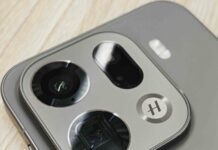![]()
Every year, Google releases a new version of the Pixel smartphone, just like Apple and Samsung. As a Pixel 7 Pro user, I am naturally excited about the new Pixel 8 series, but also eager to experience the Pixel Watch series, which is available in Singapore for the first time.
![]()
Even though the phone appears similar to the Pixel 7 Pro, the Pixel 8 Pro has different dimensions, which means the casings are not interchangeable. The new model has a matt glass back which prevents fingerprint marks, but this feature no longer matters if you use the phone with a casing, which most people do. The 6.7-inch display is now flat on the sides, which means the screen protector can adhere snugly without popping up. The display quality appears slightly better and the fonts are smaller, so I had to upsize the font by one level to match the older model.
![]()
Moving data from Pixel 7 Pro to Pixel 8 Pro is easy. Once your old phone detects the presence of the new phone, it will even pop up a message to get started.
Without any cable, I managed to migrate all my settings, home screen layouts, wallpapers and themes, making the new device practically identical. It saves my effort to re-personalise all over again. I have to re-authenticate many of the apps before I can use them.
![]()
The bulk of the improvements on the Pixel 8 Pro are the imaging and the AI capabilities through the hardware processor, Tensor G3, and a new temperature sensor located below the camera LED flash. The three rear cameras have similar field of view coverage from the older model but the sensors have been upgraded with a larger aperture to let in more light which translates to faster shutter and lower noise. I find that the Pixel 8 Pro is less aggressive in sharpening, which makes images appear less digital. The colour saturation is also slightly elevated so the images appear less dull.
![]()
At the maximum 30x zoom, the Pixel 8 Pro maintains its ability to make sense of images thanks to its conservative extrapolation. Here, the Pixel 7 Pro’s sharpening engine creates a more positive impression of a more detailed.
It’s a different story when shooting the Pixel 8 Pro at 50MP high-res mode. The raw output allows users to resize using their preferred photo editing software to process the images. Shooting at high-res mode requires a bit more time to save the image.
![]()
The new Pixel 8 Pro camera can now shoot still and video macro as close as 2cm. Macro capability is one of the underrated features that makes photography more interesting and puts smartphone cameras at an advantage over DSLRs or mirrorless, as these conventional cameras require different macro lenses to capture super close-ups.
The camera app is redesigned to provide more shooting controls before hitting the shutter. Tap the settings icon in the lower-right corner to bring up adjustments to brightness, shadow, and white balance, as well as manual focus, shutter speed and ISO. Tapping the settings icon in the lower-left corner, I can switch to manual lens selection, providing greater shooting controls.
![]()
Taking photos is only half the fun. The Pixel 8 Pro offers many AI-driven editing capabilities to improve the images. I have tried many of the editing features and find that they work relatively well.
In “Best Take”, the Google Photo app provided suggestions on swapping some of the faces with better expressions. In “Magic Editor”, the app cleverly traces the subject accurately for me to reposition and resize to another area. It then tries to fill in the details. I find the results very convincing as long as I do not push the edit too extreme.
![]()
In “Audio Magic Eraser”, analyses the audio content, identifies the types of audio, like noise, crowd, and speech, and allows me to adjust the audio levels for each type of audio. It is quite effective in reducing the level but not removing it entirely.
Other features that are already available in previous Pixels include “Magic Eraser”, and “Photo Unblur”. The cool thing is that you can edit any photos shot by non-Pixel cameras as long as you use the Pixel 8 Pro to do the editing.
Besides the upgraded camera system, the new Tensor G3 chip is designed to deliver on-device machine learning and generative AI. With the Pixel 8 Pro, it is easier to read on-screen content by telling Google Assistant to “read this article”, and even more amazing, it can accurately translate the page to another language and read aloud promptly with a natural accent.
I am pleased that Google Assistant can handle speech-to-text better, which is exceedingly useful for replying to messages from the Pixel Watch 2 since it is not convenient to type on the small round surface.
![]()
Speaking of which, the new Pixel Watch 2 feels like a natural extension of the smartphone. The initial setup takes a while as I have to go through on-screen prompts to install Fitbit, log in to my Google account, and update firmware. Fortunately, I only need to do it once, thanks to the ability to transfer the Pixel Watch 2 to a new phone without resetting.
The Pixel Watch 2 is practically a “Google communicator” on the wrist. When it comes to communication, I can rely on the Pixel Watch 2 to read and reply. The Wear OS now supports more apps to be installed natively into the Watch, like Gmail and WhatsApp, which means you can browse all your chats and send messages on it without touching your phone.
The Google Home is also available and you can control the smart devices. I feel confident about getting on with my life without having the phone with me all the time, as the Pixel Watch 2 offers a good amount of integration and synchronisation when it comes to managing emails, messages, calls, and accessing many Google apps like YouTube Music, Calendar, Notes, Maps, Wallet. There are also hundreds of apps that you can install from the Play Store.
More importantly, the Pixel Watch 2 keeps track of my biometry through the Fitbit app that is now tightly integrated. From the basic steps, sleep, and heart rate tracker to the advanced workout features like heart zone training, and pace training, using numerous sensors including skin temperature, the Pixel Watch 2 can monitor my overall wellness, stress and mood. It is comfortable enough for me to wear to bed and to wake me up with the alarm.
![]()
For peace of mind, the Watch provides access to medical info, fall detection, supports emergency sharing and a safety check feature that automatically makes a call to designated contacts if the wearer does not respond at the end of the timer. And since the Watch contains so much personal information, there is an option to enable a screen lock.
The overall usability of the Watch vastly improves when it has consistently offered me up to 2 days in between charges. The consumption is so low that I can start the day at less than 50% and end the day with more than 10% remaining. The crown proves to be quite useful as it functions as a click button as well as a scroll for the screen display. An additional button above the crown opens recent apps. The watch band is easy to remove while secure enough to prevent accidental removal. I would prefer the watch size to be slightly bigger.
Most smartphone makers continue to drive their products with faster performances, better cameras, or brighter displays. Google has long taken a different path of delivering a product focused on AI.
The Google Pixel 8 Pro and Pixel Watch 2 puts you at the forefront of AI technology, elevating your experience with machine-learning features that provide intuitive and helpful responses to your information needs.
This is one of the biggest reasons why I have enjoyed using Pixel products for many years even though they may not have the best battery life, the best camera system, or the fastest processor, because Google makes the smartest smartphones.








